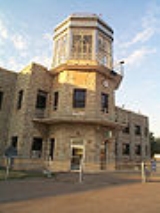
Holman Field Administration Building
Encyclopedia
The Holman Field Administration Building is a Kasota limestone
building designed by Clarence Wigington and built in 1939 by WPA
employees. It serves as the control building for the St. Paul Downtown Airport
in Saint Paul
in the U.S.
state of Minnesota
. The airport was named for Charles W. Holman, who won the U.S. air speed trials in 1930. The airfield was built on the former site of Lamprey Lake, which was filled with dredged material from the adjacent Mississippi River
, which regularly floods the airport. Across the river in Indian Mounds Park is one of the last remaining airway beacon
s in the country.
During World War II
, Northwest Airlines
employed up to 5000 people at the site, modifying new B-24 Liberator
bombers, some of which received the highly classified H2X
radar
, which proved to be an invaluable tool in the European theater.
Kasota limestone
Kasota limestone or simply, 'Kasota stone,' is a dolomitic limestone found in southern Minnesota. This sedimentary rock is part of the Oneota Dolostone Formation of southern Minnesota and is approximately 450 million years old...
building designed by Clarence Wigington and built in 1939 by WPA
Works Progress Administration
The Works Progress Administration was the largest and most ambitious New Deal agency, employing millions of unskilled workers to carry out public works projects, including the construction of public buildings and roads, and operated large arts, drama, media, and literacy projects...
employees. It serves as the control building for the St. Paul Downtown Airport
St. Paul Downtown Airport
St. Paul Downtown Airport , also known as Holman Field, is an airport just across the Mississippi River from downtown Saint Paul, Minnesota. It is one of several reliever airports in the Twin Cities operated by the Metropolitan Airports Commission...
in Saint Paul
Saint Paul, Minnesota
Saint Paul is the capital and second-most populous city of the U.S. state of Minnesota. The city lies mostly on the east bank of the Mississippi River in the area surrounding its point of confluence with the Minnesota River, and adjoins Minneapolis, the state's largest city...
in the U.S.
United States
The United States of America is a federal constitutional republic comprising fifty states and a federal district...
state of Minnesota
Minnesota
Minnesota is a U.S. state located in the Midwestern United States. The twelfth largest state of the U.S., it is the twenty-first most populous, with 5.3 million residents. Minnesota was carved out of the eastern half of the Minnesota Territory and admitted to the Union as the thirty-second state...
. The airport was named for Charles W. Holman, who won the U.S. air speed trials in 1930. The airfield was built on the former site of Lamprey Lake, which was filled with dredged material from the adjacent Mississippi River
Mississippi River
The Mississippi River is the largest river system in North America. Flowing entirely in the United States, this river rises in western Minnesota and meanders slowly southwards for to the Mississippi River Delta at the Gulf of Mexico. With its many tributaries, the Mississippi's watershed drains...
, which regularly floods the airport. Across the river in Indian Mounds Park is one of the last remaining airway beacon
Airway Beacon
An Airway beacon was a rotating light on a tower used for visual navigation by airplane pilots along a specified airway corridor. Approximately 1,500 Airway beacons were constructed, covering 18,000 miles in the U.S. to guide pilots from city to city. Construction by the Post Office and...
s in the country.
During World War II
World War II
World War II, or the Second World War , was a global conflict lasting from 1939 to 1945, involving most of the world's nations—including all of the great powers—eventually forming two opposing military alliances: the Allies and the Axis...
, Northwest Airlines
Northwest Airlines
Northwest Airlines, Inc. was a major United States airline founded in 1926 and absorbed into Delta Air Lines by a merger approved on October 29, 2008, making Delta the largest airline in the world...
employed up to 5000 people at the site, modifying new B-24 Liberator
B-24 Liberator
The Consolidated B-24 Liberator was an American heavy bomber, designed by Consolidated Aircraft of San Diego, California. It was known within the company as the Model 32, and a small number of early models were sold under the name LB-30, for Land Bomber...
bombers, some of which received the highly classified H2X
H2X radar
H2X radar was an American development of the British H2S radar, the first ground mapping radar to be used in combat. It was used by the USAAF during World War II as a navigation system for daylight overcast and nighttime operations...
radar
Radar
Radar is an object-detection system which uses radio waves to determine the range, altitude, direction, or speed of objects. It can be used to detect aircraft, ships, spacecraft, guided missiles, motor vehicles, weather formations, and terrain. The radar dish or antenna transmits pulses of radio...
, which proved to be an invaluable tool in the European theater.

